
Ungdomshuset
Encyclopedia
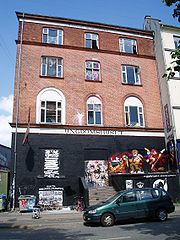
Nørrebro
Nørrebro is one of the 10 official districts of Copenhagen, Denmark. It is northwest of the city centre, beyond the location of the old Northern Gate , which, until dismantled in 1856, was near the current Nørreport station.-Geography:...
, Copenhagen
Copenhagen
Copenhagen is the capital and largest city of Denmark, with an urban population of 1,199,224 and a metropolitan population of 1,930,260 . With the completion of the transnational Øresund Bridge in 2000, Copenhagen has become the centre of the increasingly integrating Øresund Region...
, which functioned as an underground scene venue for music and rendezvous point for varying autonomen and leftist groups from 1982 until 2007 when—after prolonged conflict—it was torn down, and later also for its successor, located on Dortheavej 61 in the adjacent Bispebjerg
Bispebjerg
Bispebjerg is one of the 10 official districts of Copenhagen, Denmark. It lies on the north border of the municipality. It covers an area of 5.39 km², has a population of 40,033, and a population density of 7,389 per km²....
neighbourhood. Due to the ongoing conflict between the municipal government of Copenhagen and the activists occupying the premises, the building on Jagtvej was the subject of intense media attention and public debate from the mid-1990s till 2008.
Police started to clear the building early on Thursday, 1 March 2007. Demolition began on 5 March 2007 and was completed two days later.
Since the eviction in March 2007, former users and supporters held weekly demonstrations for a new Ungdomshuset, the demonstrations initially starting from nearby square 'Blågårds Plads' (and later Gammel Torv) every Thursday at 5 p.m. and going to various places in Copenhagen, the starting point being later changed to Gammel Torv in downtown Copenhagen as demonstrators said they were getting closer to the politicians concerning a solution for a new Ungdomshus at an old school.
In the summer of 2007, an initiative known as G13 announced that on the October 6 they'd stage a massive public attempt to squat an old public waterworks located on Grøndalsvænge Allé 13 in northwestern Copenhagen to be used as a new Ungdomshuset. The event, which gathered several thousand, was announced as non-violent, but was met with heavy opposition from the police who arrested 436 people and threw large amounts of tear gas. Recognizing that the event, which had received heavy public attention, had been carried out with peaceful means, on October 11 Ritt Bjerregaard—the Lord Mayor of Copenhagen—invited spokesmen from Ungdomshuset to have negotiations concerning a peaceful solution to the conflict.
The new Ungdomshuset opened successfully on July 1, 2008 in North-West Copenhagen's Bispebjerg
Bispebjerg
Bispebjerg is one of the 10 official districts of Copenhagen, Denmark. It lies on the north border of the municipality. It covers an area of 5.39 km², has a population of 40,033, and a population density of 7,389 per km²....
area, after more than 16 months of weekly demonstrations.
History
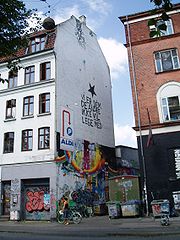
Labour movement
The term labour movement or labor movement is a broad term for the development of a collective organization of working people, to campaign in their own interest for better treatment from their employers and governments, in particular through the implementation of specific laws governing labour...
of Copenhagen. Since labour organisations were unpopular in the eyes of the authorities, and reprisals were often carried out against them, the organisations had to build their own headquarters—Folkets Hus was the fourth of these to be built. The roots of several demonstrations and meetings were planted in Folkets Hus, and as a result it was strongly linked to the great demonstration against unemployment in 1918 when workers stormed the Danish Stock Exchange
Copenhagen Stock Exchange
The Copenhagen Stock Exchange or CSE is an international marketplace for Danish securities, including shares, bonds, treasury bills and notes, and financial futures and options...
(Børsen). In 1910, The Second International
Second International
The Second International , the original Socialist International, was an organization of socialist and labour parties formed in Paris on July 14, 1889. At the Paris meeting delegations from 20 countries participated...
held an International Women's conference at the house, during which Clara Zetkin
Clara Zetkin
Clara Zetkin was a German Marxist theorist, activist, and fighter for women's rights. In 1910, she organized the first International Women's Day....
launched the idea of an International Women's Day
International Women's Day
International Women's Day , originally called International Working Women’s Day, is marked on March 8 every year. In different regions the focus of the celebrations ranges from general celebration of respect, appreciation and love towards women to a celebration for women's economic, political and...
. Lenin and Rosa Luxemburg
Rosa Luxemburg
Rosa Luxemburg was a Marxist theorist, philosopher, economist and activist of Polish Jewish descent who became a naturalized German citizen...
visited the centre.
During the 1950s it was still primarily used by the different sections, associations and unions of the labour movement. All kinds of different activities took place: for example, boxing matches and end-of-season dances.
Several years later Brugsen
Brugsen
right|thumb|250px|A Dagli'Brugsen in Northeast Copenhagen. Brugsen is a shorthand for the Danish word 'Brugsforeningen', which means consumers' cooperative. It is also the name of a Danish supermarket chain which was born as a consumers' cooperative....
, a Danish chain of co-operative supermarket
Supermarket
A supermarket, a form of grocery store, is a self-service store offering a wide variety of food and household merchandise, organized into departments...
s, bought Folkets Hus, planning to tear down the building and build a supermarket in its place. However, as this was prohibited due to the historic importance of the place, Brugsen sold the ground to the folk music ensemble Tingluti in 1978. As a consequence of a burst water main which they could not afford to repair, Tingluti had to sell the ground to the municipality of Copenhagen. The price at the time was DKK 700,000.
In 1982 Folkets Hus was assigned to a group of young people—the original founders of Ungdomshuset—although the municipality of Copenhagen still owned the building. It was at this time that the building was given its current name: Ungdomshuset. Nick Cave
Nick Cave
Nicholas Edward "Nick" Cave is an Australian musician, songwriter, author, screenwriter, and occasional film actor.He is best known for his work as a frontman of the critically acclaimed rock band Nick Cave and the Bad Seeds, established in 1984, a group known for its eclectic influences and...
and Björk
Björk
Björk Guðmundsdóttir , known as Björk , is an Icelandic singer-songwriter. Her eclectic musical style has achieved popular acknowledgement and popularity within many musical genres, such as rock, jazz, electronic dance music, classical and folk...
played there.
In January 1996 Ungdomshuset was ravaged by a fire and found to be plagued by fungus
Fungus
A fungus is a member of a large group of eukaryotic organisms that includes microorganisms such as yeasts and molds , as well as the more familiar mushrooms. These organisms are classified as a kingdom, Fungi, which is separate from plants, animals, and bacteria...
and rot. The municipality of Copenhagen decided to close the house, claiming that it would be too expensive to repair the damages and renovate the building. The activists of the house decided to fix the damages themselves and on March 1 of the next year, their work was approved by the fire prevention department.
In 1999 the building was put on sale to the highest bidder by the municipality following controversy on the renovation of the building and a refusal from the inhabitants to pay the rent agreed upon in the original contract. This prodded the users of the building to post a large banner on the facade with the message: "For sale along with 500 autonome
Autonomism
Autonomism refers to a set of left-wing political and social movements and theories close to the socialist movement. As an identifiable theoretical system it first emerged in Italy in the 1960s from workerist communism...
, stone throwing, violent psychopaths from hell.". Despite this ominous warning, a company called Human A/S bought the building in December 2000 (although ownership did not actually change hands until 2001), after which Human A/S was sold to the independent Christian sect "Faderhuset
Faderhuset
Faderhuset is a Danish evangelical Christian sect based in the Copenhagen capital region. Faderhuset is best known for acquiring the ownership of the building in central Copenhagen known as Ungdomshuset, a building also claimed by young people from the Danish left-wing movement...
". However, the squatters refused to leave the house. Until 1 March 2007 the young squatters used the house as if the change of ownership had not happened and the new owners were not allowed inside at any time.
The Ungdomshuset received more than 500 visitors a week.
Ownership controversy
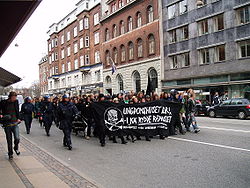
On 7 January 2004 the verdict from City Court arrived, stating that Faderhuset
Faderhuset
Faderhuset is a Danish evangelical Christian sect based in the Copenhagen capital region. Faderhuset is best known for acquiring the ownership of the building in central Copenhagen known as Ungdomshuset, a building also claimed by young people from the Danish left-wing movement...
was entitled to sue four activists (rather than Ungdomshuset itself) since Ungdomshuset functions without a hierarchical management and is therefore not regarded as an organisation. The court, however, denied Faderhuset compensation.
Both sides appealed against the decision; Faderhuset
Faderhuset
Faderhuset is a Danish evangelical Christian sect based in the Copenhagen capital region. Faderhuset is best known for acquiring the ownership of the building in central Copenhagen known as Ungdomshuset, a building also claimed by young people from the Danish left-wing movement...
demanding compensation and Ungdomshuset demanding future right of usage. On 28 August 2006 the National Court stated, as the City Court did, that the right of ownership and usage of Ungdomshuset belonged to Faderhuset and it was free to evict the inhabitants.
Originally, this decision ordered the current occupants out by 9:00 a.m. on the morning of 14 December 2006. Ungdomshuset was also denied the right of appeal to the Supreme Court, meaning that they had no further options within the legal system. The police, however, stated that they would not evict the activists until 2007.
The activists refused to leave the house and barricaded themselves inside. In addition, an open-letter
Open letter
An open letter is a letter that is intended to be read by a wide audience, or a letter intended for an individual, but that is nonetheless widely distributed intentionally....
stating "Troublemakers of the World; We bid you Welcome!" had been sent to different autonomous groups around the world, asking for help defending the house in the event of a forced eviction.
On 12 December, Faderhuset
Faderhuset
Faderhuset is a Danish evangelical Christian sect based in the Copenhagen capital region. Faderhuset is best known for acquiring the ownership of the building in central Copenhagen known as Ungdomshuset, a building also claimed by young people from the Danish left-wing movement...
refused an offer from the foundation "Jagtvej 69" to sell the house for DKK 13 million.
On 16 December, around 2000 activists, some of them foreigners, demonstrated in Copenhagen in support of Ungdomshuset. The police had not been notified of the demonstration. The vanguard of the demonstration wore masks or helmets, which is not permitted by law during demonstrations in Denmark. The police ordered the demonstration to break up and the demonstrators to disperse. The demonstrators attacked the police; stones and fireworks
Fireworks
Fireworks are a class of explosive pyrotechnic devices used for aesthetic and entertainment purposes. The most common use of a firework is as part of a fireworks display. A fireworks event is a display of the effects produced by firework devices...
were thrown at the police and burning barricades set up. The demonstration degenerated into what the police characterised as the worst riots in Denmark in many years—they used teargas, which was a very rare occurrence in Denmark. Both police and demonstrators were injured.
By the end of the night 273 people had been arrested. The majority of those arrested were released the following day, 17 December. The total number of demonstrators arrested was amongst the highest for a single event in Denmark since World War II
World War II
World War II, or the Second World War , was a global conflict lasting from 1939 to 1945, involving most of the world's nations—including all of the great powers—eventually forming two opposing military alliances: the Allies and the Axis...
. The fury of the demonstrators was described by the police as the worst since 18 May 1993, when another violent demonstration (this time against Danish EU membership) by the extreme left injured 92 officers and 11 demonstrators.
Clearance
On 1 March 2007 Ungdomshuset was cleared of its occupants by the police at about 7:00 (CETCentral European Time
Central European Time , used in most parts of the European Union, is a standard time that is 1 hour ahead of Coordinated Universal Time . The time offset from UTC can be written as +01:00...
) in the morning. A 50 metre area surrounding the building was sealed off. The building was taken with assistance from a military helicopter, an airport crash tender
Airport Crash Tender
An airport crash tender is a specialised fire engine designed for use at aerodromes and airports in aircraft accidents.Airport Crash Tenders are extremely powerful machines...
and two boom cranes, used as a form of modern day siege towers. Special forces entered the building from the roof, the windows and the ground, while the house was covered in foam to diminish the effectiveness of possible counter attacks such as Molotov cocktails. Afterwards the supporters of Ungdomshuset announced that it was "either an Ungdomshus or a battle for an Ungdomshus — the clearing will never be forgiven". Rioting broke out, including a blockade of Nørrebrogade, the main street of Nørrebro
Nørrebro
Nørrebro is one of the 10 official districts of Copenhagen, Denmark. It is northwest of the city centre, beyond the location of the old Northern Gate , which, until dismantled in 1856, was near the current Nørreport station.-Geography:...
, and fires in the areas surrounding Freetown Christiania
Freetown Christiania
Not to be confused with Christiania, Norway, another name for Oslo.Christiania, also known as Freetown Christiania is a self-proclaimed autonomous neighbourhood of about 850 residents, covering 34 hectares in the borough of Christianshavn in the Danish capital Copenhagen...
and south of Nørrebrogade. Containers were turned over, windows were broken. Molotov cocktail
Molotov cocktail
The Molotov cocktail, also known as the petrol bomb, gasoline bomb, Molotov bomb, fire bottle, fire bomb, or simply Molotov, is a generic name used for a variety of improvised incendiary weapons...
s were thrown out by the demonstrators, at the cries of "The street are ours!" Setting up barricade
Barricade
Barricade, from the French barrique , is any object or structure that creates a barrier or obstacle to control, block passage or force the flow of traffic in the desired direction...
s, they played alter-globalization
Alter-globalization
Alter-globalization is the name of a social movement that supports global cooperation and interaction, but which opposes the negative effects of economic globalization, feeling that it often works to the detriment of, or does not...
songs such as Manu Chao
Manu Chao
Manu Chao , is a French singer of Spanish roots . He sings in French, Spanish, English, Italian, Galician, Arabic and Portuguese and occasionally in other languages...
from trucks. Riot police used tear gas (CS gas
CS gas
2-chlorobenzalmalononitrile is the defining component of a "tear gas" commonly referred to as CS gas, which is used as a riot control agent...
) on several occasions throughout the riots.The entire area was unsafe and neighbors to Ungdomshuset were told to stay indoors. It was unsafe to walk the streets because of the riots and because the police proclaimed that anyone without a valid reason for being on the streets would be arrested. There were also demonstrations in Oslo carried out by the Blitz community. The police moved out with police dogs and were prepared to use tear gas
On 3 March 2007, there was more rioting outside Ungdomshuset, and by 12:36 am local time, the area of Nørrebro was completely overrun. At the same time further riots were taking place in the area around Freetown Christiania
Freetown Christiania
Not to be confused with Christiania, Norway, another name for Oslo.Christiania, also known as Freetown Christiania is a self-proclaimed autonomous neighbourhood of about 850 residents, covering 34 hectares in the borough of Christianshavn in the Danish capital Copenhagen...
. Rioters used cars and rubbish bins to build barricades and set fires on the streets. One fire spread to a nearby kindergarten but was quickly extinguished. In a secondary school
Gymnasium (school)
A gymnasium is a type of school providing secondary education in some parts of Europe, comparable to English grammar schools or sixth form colleges and U.S. college preparatory high schools. The word γυμνάσιον was used in Ancient Greece, meaning a locality for both physical and intellectual...
, the library and media room were ransacked and books and computers were burned on the street. The cost of the damages at the school was estimated to be around 1 million Danish kroner (133,000 euro
Euro
The euro is the official currency of the eurozone: 17 of the 27 member states of the European Union. It is also the currency used by the Institutions of the European Union. The eurozone consists of Austria, Belgium, Cyprus, Estonia, Finland, France, Germany, Greece, Ireland, Italy, Luxembourg,...
s).
On the same day, the famous Little Mermaid was painted pink and a graffiti '69' and circle-A was painted on the stone on which the statue rests. Although police would not confirm a link between this event and the Ungdomshuset riots, the graffiti seems a reference to the squat's address, and news sources around the world used the incident to mention the March 3 riots at the same time.
Also that morning, police raided six to eight addresses in Nørrebro in an attempt to find and deport foreign activists. Although foreigners were the primary target of these raids, a larger number of those arrested were Danes. The members of Ungdomshuset's legal support group (retsgruppen) were supposedly amongst those arrested, but police described this as 'purely coincidental'.
In total, the police carried out raids searching for activists for six days and six nights, for example at the People's House of Stengade, at an independent collective in Baldersgade, at the Solidaritetshuset and in many personal flats in Copenhagen. More than 140 foreigners were arrested on the grounds of "presumption of danger", without being charged. This was denounced by the Association of Parents against Police Brutality
Police brutality
Police brutality is the intentional use of excessive force, usually physical, but potentially also in the form of verbal attacks and psychological intimidation, by a police officer....
. Many under-age people were arrested and registered in data bases. The frontiers were controlled. In total, 690 arrests were made in three days.
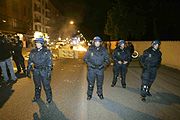
Le Monde diplomatique
Le Monde diplomatique is a monthly newspaper offering analysis and opinion on politics, culture, and current affairs. It was first created mainly for a diplomatic audience as its name implies...
as "a 'laboratory experience' in police repression." Twenty Swedish police vehicles were brought over from Malmö
Malmö
Malmö , in the southernmost province of Scania, is the third most populous city in Sweden, after Stockholm and Gothenburg.Malmö is the seat of Malmö Municipality and the capital of Skåne County...
, and five senior Swedish police officials invited for observation. Witnesses have claimed that plainclothes
Undercover
Being undercover is disguising one's own identity or using an assumed identity for the purposes of gaining the trust of an individual or organization to learn secret information or to gain the trust of targeted individuals in order to gain information or evidence...
police agents, wearing earphones, circulated in the scene of the riots, speaking foreign languages (German, French and English). Asked by a Danish newspaper, the Copenhagen's police's spokesman denied the presence of active units from others countries. However, he recognized that, "if there had been" some, it was "in quality of observers". Other analysts noticed that the same tactics used by the French police during the 2006 students' protests
2006 labour protests in France
The 2006 youth protests in France occurred throughout France during February, March, and April 2006 as a result of opposition to a measure set to deregulate labour...
against the First Employment Contract
First Employment Contract
The contrat première embauche was a new form of employment contract pushed in spring 2006 in France by Prime Minister Dominique de Villepin...
(CPE) had been used: special units of undercover agents moving around the demonstrators, and suddenly grabbing those who seemed to be the leaders. Since the Internet had been used by the demonstrators to coordinate their movements, hour by hour, informing about the police's whereabouts, a new priority of the police forces, according to Le Monde diplomatique, was to pirate this information.
Demolition
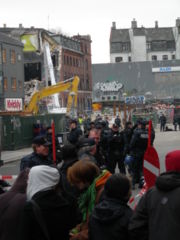

Germany has seen more than twenty actions and there have also been solidarity protests in Austria, Finland, the Netherlands, Italy, Norway, Sweden and Poland. There were also protests in front of Denmark's UN Consulate in New York City — although it only counted eight persons during the -8 Celsius weather.
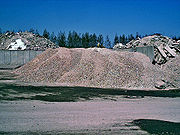
Funen
Funen , with a size of 2,984 km² , is the third-largest island of Denmark following Zealand and Vendsyssel-Thy, and the 163rd largest island of the world. Funen is located in the central part of the country and has a population of 454,358 inhabitants . The main city is Odense, connected to the...
or to Jylland. A penitentiary
Prison
A prison is a place in which people are physically confined and, usually, deprived of a range of personal freedoms. Imprisonment or incarceration is a legal penalty that may be imposed by the state for the commission of a crime...
building of Copenhagen had to be partially emptied of its common law
Common law
Common law is law developed by judges through decisions of courts and similar tribunals rather than through legislative statutes or executive branch action...
detainees to make place for the arrested youth. From March 10 to March 19, Nørrebro
Nørrebro
Nørrebro is one of the 10 official districts of Copenhagen, Denmark. It is northwest of the city centre, beyond the location of the old Northern Gate , which, until dismantled in 1856, was near the current Nørreport station.-Geography:...
and Christianshavn
Christianshavn
Christianshavn is an artificial island neighbourhood located in Copenhagen, Denmark. It was founded in the early 17th century by Christian IV as part of his extension of the fortifications of Copenhagen. Originally it was laid out as an independent privileged merchant's town with inspiration from...
were decreed zones where any citizen could be searched and registered on data bases, even without reasonable grounds for suspicion.
On the 1 of March 2007, 150 people gathered around the Danish
Denmark
Denmark is a Scandinavian country in Northern Europe. The countries of Denmark and Greenland, as well as the Faroe Islands, constitute the Kingdom of Denmark . It is the southernmost of the Nordic countries, southwest of Sweden and south of Norway, and bordered to the south by Germany. Denmark...
Embassy in Oslo
Oslo
Oslo is a municipality, as well as the capital and most populous city in Norway. As a municipality , it was established on 1 January 1838. Founded around 1048 by King Harald III of Norway, the city was largely destroyed by fire in 1624. The city was moved under the reign of Denmark–Norway's King...
, protesting against the demolition of "Ungeren". They threw paint and snowballs against the Embassy. The Norwegian Police was at presence, with a great number of Police
Police
The police is a personification of the state designated to put in practice the enforced law, protect property and reduce civil disorder in civilian matters. Their powers include the legitimized use of force...
officers.
On 16 March 2007, Danish police admitted to having mistakenly used a potentially lethal form of teargas canisters. The gas, known as Ferret 40, was used against crowds during the riots following the demolition, although the launching mechanism is designed to penetrate doors and walls.
According to Professor Lars Dencik, from the University of Roskilde, the Danish state used the opportunity of this evacuation to test its anti-terrorist security forces (as any other opportunity, or real danger, was non-existent).
On Monday 22 December 2008, five women and ten men who were present in the house at the time of eviction, received sentences of imprisonment. Eleven people were sentenced to one year and three months, three people to one year and one (aged under 16) to nine months. They were sentenced with preparing to assault police officers, and preparing violence. The court case started on 22 August 2008 and the sentences were based on the fact that police officers found, among other things, Molotov cocktails and illegal fireworks during the eviction.
See also
- AutonomismAutonomismAutonomism refers to a set of left-wing political and social movements and theories close to the socialist movement. As an identifiable theoretical system it first emerged in Italy in the 1960s from workerist communism...
- Battle of RyesgadeBattle of RyesgadeThe Battle of Ryesgade was a nine-day series of street fights in mid-September 1986, in the Copenhagen street Ryesgade. It was the most violent event in a long-standing conflict between the Copenhagen city council and the city's community of squatters...
- The BlitzBlitz (movement)Blitz is an anarchist, communist and socialist youth community in Oslo, Norway, founded in 1982. The group has often been criticized for their use of violent methods of political protest.- The house :...
in OsloOsloOslo is a municipality, as well as the capital and most populous city in Norway. As a municipality , it was established on 1 January 1838. Founded around 1048 by King Harald III of Norway, the city was largely destroyed by fire in 1624. The city was moved under the reign of Denmark–Norway's King...
, NorwayNorwayNorway , officially the Kingdom of Norway, is a Nordic unitary constitutional monarchy whose territory comprises the western portion of the Scandinavian Peninsula, Jan Mayen, and the Arctic archipelago of Svalbard and Bouvet Island. Norway has a total area of and a population of about 4.9 million... - Freetown ChristianiaFreetown ChristianiaNot to be confused with Christiania, Norway, another name for Oslo.Christiania, also known as Freetown Christiania is a self-proclaimed autonomous neighbourhood of about 850 residents, covering 34 hectares in the borough of Christianshavn in the Danish capital Copenhagen...
- SquattingSquattingSquatting consists of occupying an abandoned or unoccupied space or building, usually residential, that the squatter does not own, rent or otherwise have permission to use....
- TurbonegroTurbonegroTurbonegro is a Norwegian punk rock band that was initially active from 1989 to 1998, and later reformed in 2002. Their style combines glam rock, punk rock and hard rock into a style the band describes as "deathpunk"....
(first show at Ungdomshuset in 1989) - Kunsthaus TachelesKunsthaus TachelesThe Kunsthaus Tacheles , is an art center in Berlin, a large building on Oranienburger Straße in the district known as Mitte. Huge, colorful graffiti-style murals are painted on the exterior walls, and modern art sculptures are featured inside...
External links
- Photos from Ungdomshuset, Nathue.dk
- Propaganda calling to action for Ungdomshuset, Youtube.com
- Violent demonstration in central Copenhagen, PolitikenPolitikenPolitiken is a Danish daily broadsheet newspaper, published by JP/Politikens Hus.The newspaper comes third among Danish newspapers in terms of both number of readers and circulated copies ....
- Photo gallery of the riots on 16 December 2006
- Photo gallery featuring three Ungdomshuset demos in 2006
- English translation of events in Copenhagen from 1 March 2007 onwards
- Danish police arrests hundreds, BBC NewsBBC NewsBBC News is the department of the British Broadcasting Corporation responsible for the gathering and broadcasting of news and current affairs. The department is the world's largest broadcast news organisation and generates about 120 hours of radio and television output each day, as well as online...
- Links to news stories on the December 16th riots, Google NewsGoogle NewsGoogle News is a free news aggregator provided by Google Inc, selecting recent items from thousands of publications by an automatic aggregation algorithm....
- December 16 riots, with video. Jyllands Postens
- Has Ungdomshuset Reached the End of Its Road?, Ungdomshuset's interview in Indymedia 30.11.2006
- Chronology of Eviction of 3/1/2007, Indymedia
- Ungdomshuset Raid (Indymedia DK)
- Interview with House Activists Before Eviction (Soundtracksforthem)
- G13: initiative for a new Ungdomshuset
- http://politiken.dk/udland/ECE254989/maling-og-snebolde-mod-dansk-ambassade-i-oslo/

